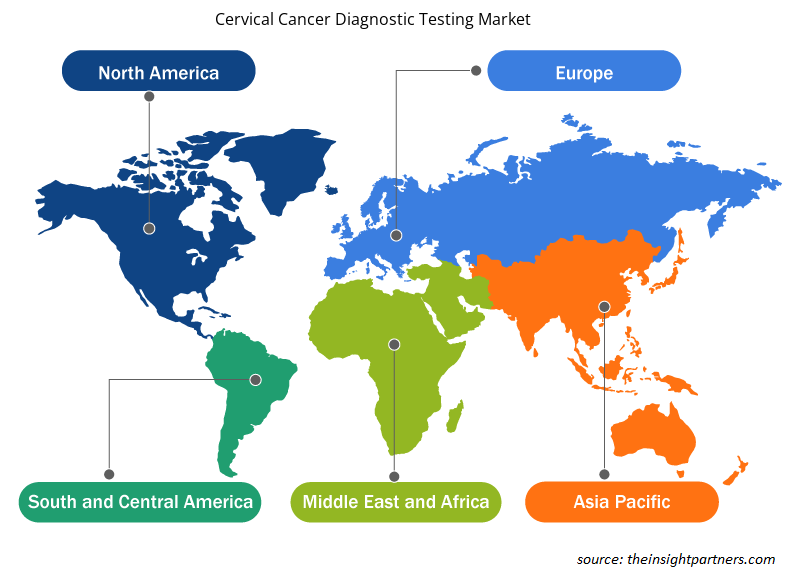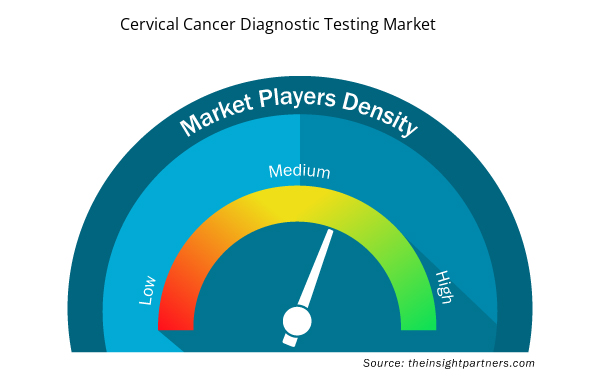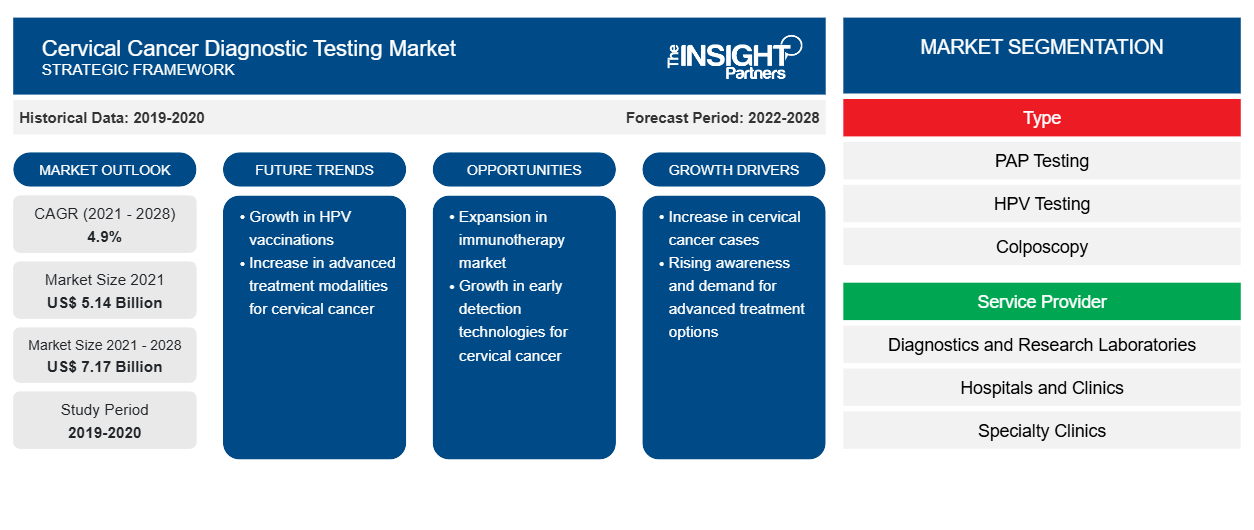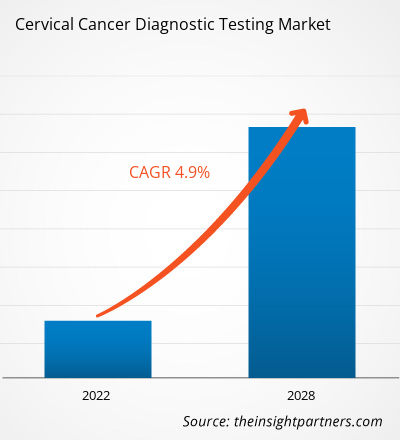Der Markt für Diagnosetests für Gebärmutterhalskrebs soll von 5.141,25 Millionen US-Dollar im Jahr 2021 auf 7.165,92 Millionen US-Dollar im Jahr 2028 anwachsen; von 2021 bis 2028 dürfte er voraussichtlich mit einer durchschnittlichen jährlichen Wachstumsrate von 4,9 % wachsen.
Gebärmutterhalskrebs hat eine hohe Sterblichkeitsrate (fast 50 %), die durch Früherkennung und Prävention gesenkt werden kann. Präkanzeröse Veränderungen bieten Möglichkeiten zur Prävention und Behandlung, da der Krankheitsverlauf oft verzögert ist. Aufgrund mangelnden Bewusstseins oder mangelnden Zugangs zu Diagnosediensten werden viele Fälle jedoch erst in späteren Stadien des Krankheitsverlaufs erkannt. Humanes Papillomavirus (HPV) ist eine Hauptursache für Gebärmutterhalskrebs und wird typischerweise durch sexuellen Kontakt übertragen. Es gibt über 100 HPV-Stämme, von denen 13 ein hohes oder krebserregendes Risiko darstellen. Das aktive Gen – E6 oder E7 – bestimmt, ob ein HPV-Stamm ein hohes oder niedriges Risiko darstellt. E6 bindet an p53 und verursacht proteolytische Zerstörung. E7 hingegen bindet an Retinoblastom; die Bindung verdrängt zuvor gebundene Transkriptionsfaktoren, was dazu führt, dass der Zellzyklus gestoppt und die Apoptoseregulierung gehemmt wird. Der HPV-Test erkennt humanes Papillomavirus in Gebärmutterhalszellen. Andere Screening-Ansätze, die in ressourcenarmen Gebieten von Entwicklungsländern eingesetzt werden, sind HPV-DNA-Tests und visuelle Untersuchungen. Regelmäßige Gebärmutterhalskrebs-Screenings helfen bei der Früherkennung von Gebärmutterhalskrebs und senken die Sterblichkeitsrate der Krankheit. Alle drei Jahre wird allen Frauen zwischen 21 und 65 Jahren empfohlen, einen Pap-Test durchführen zu lassen, und Frauen zwischen 30 und 65 Jahren wird empfohlen, sowohl einen Pap-Test als auch einen HPV-Test durchführen zu lassen. In Bezug auf den Umsatz dominierte diese Art den Markt für Gebärmutterhalskrebs-Screenings im Jahr 2021, und es wird erwartet, dass diese Dominanz im Prognosezeitraum anhält.
Passen Sie diesen Bericht Ihren Anforderungen an
Sie erhalten kostenlos individuelle Anpassungen an jedem Bericht, einschließlich Teilen dieses Berichts oder einer Analyse auf Länderebene, eines Excel-Datenpakets sowie tolle Angebote und Rabatte für Start-ups und Universitäten.
- Holen Sie sich die wichtigsten Markttrends aus diesem Bericht.Dieses KOSTENLOSE Beispiel umfasst eine Datenanalyse von Markttrends bis hin zu Schätzungen und Prognosen.
Markteinblicke:
Zunehmende Krebsprävalenz treibt Wachstum des Marktes für Diagnosetests für Gebärmutterhalskrebs im Prognosezeitraum voran
Krebs hat sich weltweit zu einer der häufigsten Todesursachen entwickelt. Laut der Weltgesundheitsorganisation (WHO) war Krebs im Jahr 2019 in 183 Ländern die häufigste Todesursache bei Menschen unter 70 Jahren und in 123 Ländern weltweit die vierthäufigste Todesursache. Darüber hinaus gab es laut im März 2021 von der WHO veröffentlichten Daten im Jahr 2020 etwa 10 Millionen Todesfälle aufgrund verschiedener Krebsarten. Die weltweit steigende Zahl von Gebärmutterhalskrebserkrankungen bei Frauen treibt das Wachstum des Marktes für Diagnosetests für Gebärmutterhalskrebs voran . Laut WHO sterben jedes Jahr mehr als 270.000 Frauen an Gebärmutterhalskrebs. Aufgrund der späten Diagnose der Krankheit ist die Sterblichkeitsrate bei Gebärmutterhalskrebs in Ländern mit niedrigem Einkommen höher. Es wird erwartet, dass der Markt in den kommenden Jahren wachsen wird, da Diagnosetests für Gebärmutterhalskrebs zur Früherkennung der Krankheit zunehmend akzeptiert werden.
Die zunehmende Verbreitung von Krebs hat die Gesundheitssysteme weltweit belastet. Laut der Internationalen Agentur für Krebsforschung (IARC) wird die weltweite Belastung durch neue Krebsfälle bis 2040 auf etwa 27,5 Millionen ansteigen, und die Krankheit wird bis dahin wahrscheinlich etwa 163 Millionen Todesfälle verursachen. Faktoren wie Veränderungen des Lebensstils, Rauchen, verringerte körperliche Aktivität sowie unsichere gesundheitliche und klimatische Bedingungen werden in den kommenden Jahren zu einer noch größeren Krebsbelastung auf der Welt führen.
Typbasierte Erkenntnisse
Der Markt für Diagnosetests für Gebärmutterhalskrebs ist nach Typ in PAP-Tests, HPV-Tests , Kolposkopie, Gebärmutterhalsbiopsien, Zystoskopie und andere unterteilt. Im Jahr 2021 hatte das Segment der PAP-Tests den größten Marktanteil und wird voraussichtlich zwischen 2021 und 2028 die höchste durchschnittliche jährliche Wachstumsrate verzeichnen.
Einblicke auf Dienstanbieterbasis
Basierend auf dem Dienstleister ist der Markt in Forschung, Diagnostik- und Forschungslabore, Krankenhäuser und Kliniken, Fachkliniken und häusliche Pflegedienste segmentiert. Im Jahr 2021 hielt das Segment Diagnostik- und Forschungslabore den größten Marktanteil und wird voraussichtlich zwischen 2021 und 2028 die höchste CAGR auf dem Markt verzeichnen.
Unternehmen, die auf dem Markt für diagnostische Tests für Gebärmutterhalskrebs tätig sind, verfolgen verschiedene Strategien wie Produktinnovationen, um den sich entwickelnden Kundenanforderungen auf der ganzen Welt gerecht zu werden und ihren Markennamen auf dem Weltmarkt zu behaupten.
Markt für Diagnosetests für Gebärmutterhalskrebs – Segmentierung
Der Markt für Diagnosetests für Gebärmutterhalskrebs ist nach Typ und Dienstleister segmentiert. Nach Typ ist der Markt in PAP-Tests, HPV-Tests, Kolposkopie, Gebärmutterhalsbiopsien, Zystoskopie und andere unterteilt. Nach Dienstleister ist der Markt weiter in Diagnose- und Forschungslabore, Krankenhäuser und Kliniken, Fachkliniken und häusliche Pflegedienste segmentiert.
Geografisch ist der Markt für Diagnosetests für Gebärmutterhalskrebs in Nordamerika (USA, Kanada und Mexiko), Europa (Frankreich, Deutschland, Italien, Großbritannien, Spanien und Rest von Europa), Asien-Pazifik (Australien, China, Indien, Japan, Südkorea und Rest von Asien-Pazifik), Naher Osten und Afrika (Saudi-Arabien, Südafrika, Vereinigte Arabische Emirate und Rest von Afrika) sowie Süd- und Mittelamerika (Brasilien, Argentinien und Rest von Südafrika) segmentiert.
Regionale Einblicke in den Markt für Diagnosetests für Gebärmutterhalskrebs
Die regionalen Trends und Faktoren, die den Markt für Diagnosetests für Gebärmutterhalskrebs im Prognosezeitraum beeinflussen, wurden von den Analysten von Insight Partners ausführlich erläutert. In diesem Abschnitt werden auch die Marktsegmente und die Geografie für Diagnosetests für Gebärmutterhalskrebs in Nordamerika, Europa, im asiatisch-pazifischen Raum, im Nahen Osten und Afrika sowie in Süd- und Mittelamerika erörtert.

- Erhalten Sie regionale Daten zum Markt für Diagnosetests für Gebärmutterhalskrebs
Umfang des Marktberichts zu Diagnosetests für Gebärmutterhalskrebs
| Berichtsattribut | Details |
|---|---|
| Marktgröße im Jahr 2021 | 5,14 Milliarden US-Dollar |
| Marktgröße bis 2028 | 7,17 Milliarden US-Dollar |
| Globale CAGR (2021 - 2028) | 4,9 % |
| Historische Daten | 2019-2020 |
| Prognosezeitraum | 2022–2028 |
| Abgedeckte Segmente | Nach Typ
|
| Abgedeckte Regionen und Länder | Nordamerika
|
| Marktführer und wichtige Unternehmensprofile |
|
Dichte der Marktteilnehmer für Diagnosetests für Gebärmutterhalskrebs: Auswirkungen auf die Geschäftsdynamik verstehen
Der Markt für Diagnosetests für Gebärmutterhalskrebs wächst rasant. Dies wird durch die steigende Nachfrage der Endnutzer aufgrund von Faktoren wie sich entwickelnden Verbraucherpräferenzen, technologischen Fortschritten und einem größeren Bewusstsein für die Vorteile des Produkts vorangetrieben. Mit der steigenden Nachfrage erweitern Unternehmen ihr Angebot, entwickeln Innovationen, um die Bedürfnisse der Verbraucher zu erfüllen, und nutzen neue Trends, was das Marktwachstum weiter ankurbelt.
Die Marktteilnehmerdichte bezieht sich auf die Verteilung von Firmen oder Unternehmen, die in einem bestimmten Markt oder einer bestimmten Branche tätig sind. Sie gibt an, wie viele Wettbewerber (Marktteilnehmer) in einem bestimmten Marktraum im Verhältnis zu seiner Größe oder seinem gesamten Marktwert präsent sind.
Die wichtigsten Unternehmen auf dem Markt für Diagnosetests für Gebärmutterhalskrebs sind:
- F. HOFFMANN-LA ROCHE LTD.
- Abbott
- Quest Diagnostics GmbH
- QIAGEN
- Hologic, Inc.
Haftungsausschluss : Die oben aufgeführten Unternehmen sind nicht in einer bestimmten Reihenfolge aufgeführt.

- Überblick über die wichtigsten Akteure auf dem Markt für Diagnosetests für Gebärmutterhalskrebs
Firmenprofile
- F. Hoffmann-La Roche Ltd.
- Abbott
- Quest Diagnostics GmbH
- QIAGEN
- Hologic, Inc.
- DYSIS Medical Inc.
- Femasys Inc.
- Guided Therapeutics, Inc.
- Cooper Companies, Inc.
- BD
- Historische Analyse (2 Jahre), Basisjahr, Prognose (7 Jahre) mit CAGR
- PEST- und SWOT-Analyse
- Marktgröße Wert/Volumen – Global, Regional, Land
- Branche und Wettbewerbsumfeld
- Excel-Datensatz



Report Coverage
Revenue forecast, Company Analysis, Industry landscape, Growth factors, and Trends

Segment Covered
This text is related
to segments covered.

Regional Scope
North America, Europe, Asia Pacific, Middle East & Africa, South & Central America

Country Scope
This text is related
to country scope.
Häufig gestellte Fragen
Asia Pacific is registered as the fastest-growing region in the global cervical cancer diagnostic testing market. The market is this region is expected to grow significantly in countries such as China, Japan, and India. The market is driven by the increasing prevalence of cervical cancer in developing countries, including China, India, Malaysia, Japan, South Korea, and Australia.
The cervical cancer diagnostic testing market based on type is segmented into PAP testing, HPV testing, colposcopy, cervical biopsies, cystoscopy, others. In 2021, the PAP Testing segment accounted for the highest share. Besides, the HPV testing segment is expected to grow at a CAGR of 5.5% in the forecast period.
The global cervical cancer diagnostic testing market is segmented into North America, Europe, Asia Pacific, Middle East & Africa, and South & Central America. The North American area holds the largest market for aesthetic skin devices. The United States held the most significant cervical cancer diagnostic testing market and is expected to grow due to factors such as high awareness about disease prevention among women in the region, as well as to the many initiatives launched to prevent cervical cancer, which have increased the reach of insurance coverage for cervical screening tests, especially for low-income women, and others.
The cervical cancer diagnostic testing market majorly consists of the players such as as F. Hoffmann-La Roche Ltd., Abbott, Quest Diagnostics Incorporated, QIAGEN, Hologic, Inc., DYSIS Medical Inc., Femasys Inc., Guided Therapeutics, Inc, Cooper Companies, Inc., BD are amongst others.
Cervical Cancer refers to cancer that occurs in the cells of the cervix i.e. the lower part of the uterus that connects to the vagina. In 90% of the cases, cervical malignancies occur due to the HPV infection and are diagnosed through smear screening.
The factors that are driving and restraining factors that will affect the cervical cancer diagnostic testing market in the coming years. Factors such as the increasing prevalence of cancer and the rise in HPV infections are driving the market growth. However, less number of commercially available vaccines for the treatment of cancer are likely to hamper the growth of the market.
Trends and growth analysis reports related to Life Sciences : READ MORE..
The List of Companies - Cervical Cancer Diagnostic Testing Market
- F. HOFFMANN-LA ROCHE LTD.
- Abbott
- Quest Diagnostics Incorporated
- QIAGEN
- Hologic, Inc.
- DYSIS Medical Inc
- Femasys Inc.
- GUIDED THERAPEUTICS, INC
- Cooper Companies, Inc.
- BD
The Insight Partners performs research in 4 major stages: Data Collection & Secondary Research, Primary Research, Data Analysis and Data Triangulation & Final Review.
- Data Collection and Secondary Research:
As a market research and consulting firm operating from a decade, we have published and advised several client across the globe. First step for any study will start with an assessment of currently available data and insights from existing reports. Further, historical and current market information is collected from Investor Presentations, Annual Reports, SEC Filings, etc., and other information related to company’s performance and market positioning are gathered from Paid Databases (Factiva, Hoovers, and Reuters) and various other publications available in public domain.
Several associations trade associates, technical forums, institutes, societies and organization are accessed to gain technical as well as market related insights through their publications such as research papers, blogs and press releases related to the studies are referred to get cues about the market. Further, white papers, journals, magazines, and other news articles published in last 3 years are scrutinized and analyzed to understand the current market trends.
- Primary Research:
The primarily interview analysis comprise of data obtained from industry participants interview and answers to survey questions gathered by in-house primary team.
For primary research, interviews are conducted with industry experts/CEOs/Marketing Managers/VPs/Subject Matter Experts from both demand and supply side to get a 360-degree view of the market. The primary team conducts several interviews based on the complexity of the markets to understand the various market trends and dynamics which makes research more credible and precise.
A typical research interview fulfils the following functions:
- Provides first-hand information on the market size, market trends, growth trends, competitive landscape, and outlook
- Validates and strengthens in-house secondary research findings
- Develops the analysis team’s expertise and market understanding
Primary research involves email interactions and telephone interviews for each market, category, segment, and sub-segment across geographies. The participants who typically take part in such a process include, but are not limited to:
- Industry participants: VPs, business development managers, market intelligence managers and national sales managers
- Outside experts: Valuation experts, research analysts and key opinion leaders specializing in the electronics and semiconductor industry.
Below is the breakup of our primary respondents by company, designation, and region:

Once we receive the confirmation from primary research sources or primary respondents, we finalize the base year market estimation and forecast the data as per the macroeconomic and microeconomic factors assessed during data collection.
- Data Analysis:
Once data is validated through both secondary as well as primary respondents, we finalize the market estimations by hypothesis formulation and factor analysis at regional and country level.
- Macro-Economic Factor Analysis:
We analyse macroeconomic indicators such the gross domestic product (GDP), increase in the demand for goods and services across industries, technological advancement, regional economic growth, governmental policies, the influence of COVID-19, PEST analysis, and other aspects. This analysis aids in setting benchmarks for various nations/regions and approximating market splits. Additionally, the general trend of the aforementioned components aid in determining the market's development possibilities.
- Country Level Data:
Various factors that are especially aligned to the country are taken into account to determine the market size for a certain area and country, including the presence of vendors, such as headquarters and offices, the country's GDP, demand patterns, and industry growth. To comprehend the market dynamics for the nation, a number of growth variables, inhibitors, application areas, and current market trends are researched. The aforementioned elements aid in determining the country's overall market's growth potential.
- Company Profile:
The “Table of Contents” is formulated by listing and analyzing more than 25 - 30 companies operating in the market ecosystem across geographies. However, we profile only 10 companies as a standard practice in our syndicate reports. These 10 companies comprise leading, emerging, and regional players. Nonetheless, our analysis is not restricted to the 10 listed companies, we also analyze other companies present in the market to develop a holistic view and understand the prevailing trends. The “Company Profiles” section in the report covers key facts, business description, products & services, financial information, SWOT analysis, and key developments. The financial information presented is extracted from the annual reports and official documents of the publicly listed companies. Upon collecting the information for the sections of respective companies, we verify them via various primary sources and then compile the data in respective company profiles. The company level information helps us in deriving the base number as well as in forecasting the market size.
- Developing Base Number:
Aggregation of sales statistics (2020-2022) and macro-economic factor, and other secondary and primary research insights are utilized to arrive at base number and related market shares for 2022. The data gaps are identified in this step and relevant market data is analyzed, collected from paid primary interviews or databases. On finalizing the base year market size, forecasts are developed on the basis of macro-economic, industry and market growth factors and company level analysis.
- Data Triangulation and Final Review:
The market findings and base year market size calculations are validated from supply as well as demand side. Demand side validations are based on macro-economic factor analysis and benchmarks for respective regions and countries. In case of supply side validations, revenues of major companies are estimated (in case not available) based on industry benchmark, approximate number of employees, product portfolio, and primary interviews revenues are gathered. Further revenue from target product/service segment is assessed to avoid overshooting of market statistics. In case of heavy deviations between supply and demand side values, all thes steps are repeated to achieve synchronization.
We follow an iterative model, wherein we share our research findings with Subject Matter Experts (SME’s) and Key Opinion Leaders (KOLs) until consensus view of the market is not formulated – this model negates any drastic deviation in the opinions of experts. Only validated and universally acceptable research findings are quoted in our reports.
We have important check points that we use to validate our research findings – which we call – data triangulation, where we validate the information, we generate from secondary sources with primary interviews and then we re-validate with our internal data bases and Subject matter experts. This comprehensive model enables us to deliver high quality, reliable data in shortest possible time.


 Holen Sie sich ein kostenloses Muster für diesen Bericht
Holen Sie sich ein kostenloses Muster für diesen Bericht